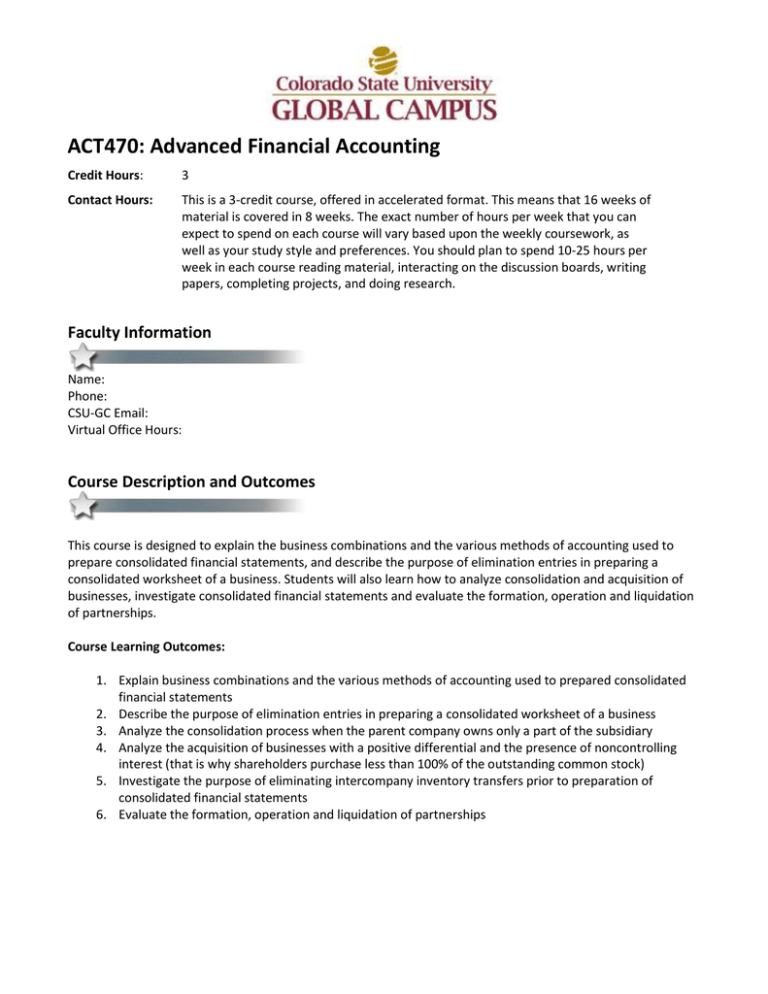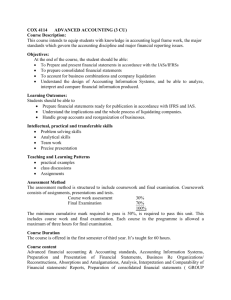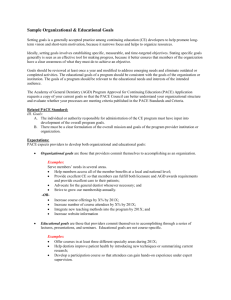ACT470: Advanced Financial Accounting
advertisement

ACT470: Advanced Financial Accounting Credit Hours: 3 Contact Hours: This is a 3-credit course, offered in accelerated format. This means that 16 weeks of material is covered in 8 weeks. The exact number of hours per week that you can expect to spend on each course will vary based upon the weekly coursework, as well as your study style and preferences. You should plan to spend 10-25 hours per week in each course reading material, interacting on the discussion boards, writing papers, completing projects, and doing research. Faculty Information Name: Phone: CSU-GC Email: Virtual Office Hours: Course Description and Outcomes This course is designed to explain the business combinations and the various methods of accounting used to prepare consolidated financial statements, and describe the purpose of elimination entries in preparing a consolidated worksheet of a business. Students will also learn how to analyze consolidation and acquisition of businesses, investigate consolidated financial statements and evaluate the formation, operation and liquidation of partnerships. Course Learning Outcomes: 1. Explain business combinations and the various methods of accounting used to prepared consolidated financial statements 2. Describe the purpose of elimination entries in preparing a consolidated worksheet of a business 3. Analyze the consolidation process when the parent company owns only a part of the subsidiary 4. Analyze the acquisition of businesses with a positive differential and the presence of noncontrolling interest (that is why shareholders purchase less than 100% of the outstanding common stock) 5. Investigate the purpose of eliminating intercompany inventory transfers prior to preparation of consolidated financial statements 6. Evaluate the formation, operation and liquidation of partnerships Participation & Attendance Prompt and consistent attendance in your online courses is essential for your success at CSU-Global Campus. Failure to verify your attendance within the first 7 days of this course may result in your withdrawal. If for some reason you would like to drop a course, please contact your advisor. Online classes have deadlines, assignments, and participation requirements just like on-campus classes. Budget your time carefully and keep an open line of communication with your instructor. If you are having technical problems, problems with your assignments, or other problems that are impeding your progress, let your instructor know as soon as possible. Course Materials Required: Baker, R. E., Christensen, D. E., & Cottrell, T. M. (2012). Essentials of advanced financial accounting. New York, NY: McGraw Hill Publishers. ISBN 9780078025648 Course Schedule Due Dates The Academic Week at CSU-Global begins on Monday and ends the following Sunday. Discussion Boards: The original post must be completed by Thursday at 12 midnight MT and Peer Responses posted by Sunday 12 midnight MT. Late posts may not be awarded points. Mastery Exercises: Students may access and retake mastery exercises through the last day of class until they achieve the scores they desire. Critical Thinking Activities: Assignments are due Sunday at 12 midnight MT. Week # Readings Chapter 1 in Essentials of Advanced Financial Accounting 1 Chapter 2 in Essentials of Advanced Financial Accounting 2 Chapter 3 in Essentials of Advanced Financial Accounting 3 Chapter 4 in Essentials of Advanced Financial Accounting 4 Chapter 5 in Essentials of Advanced Financial Accounting 5 Assignments Discussion (25 points) Mastery (10 points) Critical Thinking (50 points) Discussion (25 points) Mastery (10 points) Critical Thinking (50 points) Discussion (25 points) Mastery (10 points) Critical Thinking (50 points) Discussion (25 points) Mastery (20 points) Critical Thinking (50 points) Discussion (25 points) Mastery (10 points) Critical Thinking (50 points) Chapter 6 in Essentials of Advanced Financial Accounting 6 Chapter 10 in Essentials of Advanced Financial Accounting 7 Chapter 11 in Essentials of Advanced Financial Accounting 8 Discussion (25 points) Mastery (10 points) Critical Thinking (50 points) Discussion (25 points) Mastery (10 points) Critical Thinking (50 points) Discussion (25 points) Mastery (20 points) Portfolio (350 points) Assignment Details This course includes the following assignments/projects: Module 1: Acquisition Journal Entry (50 Points) On January 1, 201X, Alaska Corporation acquired Mercantile Corporation's net assets by paying $160,000 in cash. Balance sheet data for the two companies and fair value information for Mercantile Corporation immediately before the business combination are given below: (Source: Baker, Christensen, & Cottrell, 2012) Prepare the journal entry to record the acquisition of Mercantile Corporation. Submit your responses in MSWord as one document. Label each section clearly. For written answers, please make sure your responses are well written, adhere to CSU-Global APA formatting and writing expectations, and have the proper citation, if needed. Module 2 Consolidation Statements (50 Points) On January 1, 201X, Plimsol Company acquired 100 percent of Shipping Corporation's voting shares, at underlying book value. Plimsol uses the cost method in accounting for its investment in Shipping. Shipping's reported retained earnings of $75,000 on the date of acquisition. The trial balances for Plimsol Company and Shipping Corporation as of December 31, 201X, follow: (Source: Baker, Christensen, & Cottrell, 2012) 1. 2. Provide all eliminating entries required to prepare a full set of consolidated statements for 201X. Prepare a three-part consolidation worksheet in good form as of December 31, 201X. Submit your responses in MSWord as one document. Label each section clearly. For written answers, please make sure your responses are well written, adhere to CSU-Global APA formatting and writing expectations, and have the proper citation, if needed. Module 3 Parent Company Statements (50 points) Parent Company acquired 90 percent of Son Inc. on January 31, 20X2 in exchange for cash. The book value of Son's individual assets and liabilities approximated their acquisition-date fair values. On the date of acquisition, Son reported the following: (Source: Baker, Christensen, & Cottrell, 2012) During the year Son Inc. reported $310,000 in net income and declared $15,000 in dividends. Parent Company reported $520,000 in net income and declared $25,000 in dividends. Parent accounts for its investment using the equity method. Answer the following questions: 1. 2. 3. 4. What journal entry will Parent make on the date of acquisition to record the investment in Son Inc.? If Parent were to prepare a consolidated balance sheet on the acquisition date (January 31, 201X), what is the basic elimination entry Parent would use in the consolidation worksheet? What is Parent's balance in "Investment in Son Inc." prior to consolidation on December 31, 201X? What is the basic elimination entry Parent would use in the consolidation worksheet on December 31, 201X? Submit your responses in MSWord as one document. Label each section clearly. For written answers, please make sure your responses are well written, adhere to CSU-Global APA formatting and writing expectations, and have the proper citation, if needed. Module 4 Consolidated Balance Sheet (50 Points) Lea Company acquired all of Tenzing Corporation's stock on January 1, 20X6 for $150,000 cash. On December 31, 20X7, the balance sheets of the two companies showed the following amounts: (Source: Baker, Christensen, & Cottrell, 2012) Tenzing Corporation reported retained earnings of $75,000 at the date of acquisition. The difference between the acquisition price and underlying book value is assigned to buildings and equipment with a remaining economic life of five years from the date of acquisition. Answer the following questions: 1. 2. Give the appropriate eliminating entry or entries needed to prepare a consolidated balance sheet as of December 31, 20X7. Prepare a consolidated balance sheet worksheet as of December 31, 20X7. Submit your responses in MSWord as one document. Label each section clearly. For written answers, please make sure your responses are well written, adhere to CSU-Global APA formatting and writing expectations, and have the proper citation, if needed. Module 5 Journal Entries for Acquisition (50 Points) Magellan Corporation acquired 80 percent ownership of Dipper Corporation on January 1, 20X8, for $200,000. At that date, Dipper reported common stock outstanding of $75,000 and retained earnings of $150,000. The fair value of the noncontrolling interest was $50,000. The differential is assigned to equipment, which had a fair value $25,000 greater than book value and a remaining economic life of five years at the date of the business combination. Canton Dipper reported net income of $40,000 and paid dividends of $20,000 in 20X8. Provide the following: 1. 2. The journal entries recorded by Magellan during 20X8 on its books if it accounts for its investment in Dipper using the equity method. The eliminating entries needed at December 31, 20X8, to prepare consolidated financial statements. Submit your responses in MSWord as one document. Label each section clearly. For written answers, please make sure your responses are well written, adhere to CSU-Global APA formatting & writing expectations, and have the proper citation, if needed. Module 6 Consolidated Statements for Acquisition (50 Points) Colton Company acquired 80 percent ownership of Mota Company's voting shares on January 1, 2008, at underlying book value. The fair value of the non-controlling interest on that date was equal to 20 percent of the book value of Mota Company. During 2008, Colton purchased inventory for $30,000 and sold the full amount to Mota Company for $50,000. On December 31, 2008, Mota's ending inventory included $10,000 of items purchased from Colton. Also in 2008, Mota purchased inventory for $80,000 and sold the units to Colton for $100,000. Colton included $30,000 of its purchase from Mota in ending inventory on December 31, 2008. Summary income statement data for the two companies revealed the following: (Source: Baker, Christensen, & Cottrell, 2012) Provide the following: 1. 2. 3. 4. Compute the amount to be reported as sales in the 20X8 consolidated income statement. Compute the amount to be reported as cost of goods sold in the 20X8 consolidated income statement. What amount of income will be assigned to the non-controlling shareholders in the 20X8 consolidated income statement? What amount of income will be assigned to the controlling interest in the 20X8 consolidated income statement? Submit your responses in MSWord as one document. Label each section clearly. For written answers, please make sure your responses are well written, adhere to CSU-Global APA formatting and writing expectations, and have the proper citation, if needed. Module 7 Partnerships and Balance Sheets (50 Points) Two sole proprietors, L and M, agreed to form a partnership on January 1, 2009. The trial balance for each proprietorship is shown below as of January 1, 2009. (Source: Baker, Christensen, & Cottrell, 2012) The LM partnership will take over the assets and assume the liabilities of the proprietors as of January 1, 2009. Provide the following: 1. 2. Prepare a balance sheet, for financial accounting purposes, for the LM partnership as of January 1, 2009. In addition, assume that M agreed to recognize the goodwill generated by L's business. Accordingly, M agreed to recognize an amount for L's goodwill such that L's capital equaled M's capital on January 1, 2009. Given this alternative, how does the balance sheet prepared for #1 change? Submit your responses in MSWord as one document. Label each section clearly. For written answers, please make sure your responses are well written, adhere to CSU-Global APA formatting and writing expectations, and have the proper citation, if needed. Module 8 Portfolio Project (350 points) The Portfolio Project is a two-part project. The first part is a scenario covering the topic of consolidated financial statements. The second part is the preparation of a consolidated financial statement. Submit both parts separately. Part 1: Scenario – Written Response A new employee has been given responsibility for preparing the consolidated financial statements of Sample Company. After attempting to work alone for some time, the employee seeks assistance in gaining a better overall understanding of the way in which the consolidation process works. You have been asked to provide assistance in explaining the consolidation process. The employee is asking you to respond to the following questions. Please provide full explanations and use examples to support your work. 1. 2. 3. 4. 5. Why must the eliminating entries be entered in the consolidation worksheet each time consolidated statements are prepared? How is the beginning-of-period non-controlling interest balance determined? How is the end-of-period non-controlling interest balance determined? Provide an example. Which of the subsidiary’s account balances must always be eliminated? Why? Which of the parent company’s account balances must always be eliminated? Why? Your responses should be complete, cite appropriate examples, well written, and in conformity with CSU-Global guidelines for formatting and style. Part 2: Problem Solving - Journal Parent Corporation acquired 75 percent of Signature Company’s voting stock on January 1, 201X, at underlying book value. The fair value of the noncontrolling interest was equal to 20 percent of the book value of Signature at that date. Parent uses the fully adjusted equity method in accounting for its ownership of Signature during 201X. On December 31, 201X, the trial balances of the two companies are as follows: (Source: Baker, Christensen, & Cottrell, 2012) Complete the following items, providing written responses and spreadsheet as required: 1. 2. 3. Provide all the eliminating entries required as of December 31, 201X, to prepare consolidated financial statements and explain why these are eliminating entries. Prepare a three-part consolidation worksheet. Prepare a consolidated balance sheet, income statement and retained earnings statement for 201X. Make sure to label your answers and provide support where needed. Your responses should be complete, well written, and in conformity with CSU-Global guidelines for formatting and style. Course Policies Late Work Students are permitted a 7 day grace period during which they may submit a Critical Thinking assignment after the original due date without penalty. Papers submitted between 8 and 14 days after the original due date will be accepted with a potential 10 percent reduction in grade for late submission. Papers submitted 15 or more days beyond the original due date may not be accepted unless prior arrangements have been made with the instructor. No Portfolios will be accepted late and no assignments will be accepted after the last day of class unless a student has requested an incomplete grade in accordance with the Incomplete Policy. Course Grading Grading Scale and Policies 20% Discussion Participation 45% Critical Thinking Activities 35% Final Portfolio Paper A 95.0 – 100 A- 90.0 – 94.9 B+ 86.7 – 89.9 B 83.3 – 86.6 B- 80.0 – 83.2 C+ 75.0 – 79.9 C 70.0 – 74.9 D 60.0 – 69.9 F 59.9 or below FN* Failure for Nonparticipation I** Incomplete * Students who stop attending class and fail the course for nonparticipation will be issued the “FN” grade. The FN grade may have implications for financial aid and scholarship awards. ** An “I” grade may be assigned at the Instructor’s discretion to students who are in good standing (passing) in the course. Students should have completed a majority of the coursework in order to be eligible for the “I” grade. Students should request an "I" grade from the Instructor with a written justification, which must include explanation of extenuating circumstances that prevented timely completion of the coursework. If the request is approved, the Instructor will require a written agreement consisting of a) the specific coursework to be completed, b) the plan to complete the coursework, and c) the deadline for completion. The agreement will be kept on file at CSU-Global Campus. An incomplete course must be satisfactorily completed within the time frame stipulated in the agreement, but no later than the end of the following semester from the date the “I” was given. An incomplete not removed within one year shall convert to an F and be included in the computation of the student’s grade point average. Academic Integrity Students must assume responsibility for maintaining honesty in all work submitted for credit and in any other work designated by the instructor of the course. Academic dishonesty includes cheating, plagiarism, unauthorized possession of academic materials, and falsification. The Student Handbook provides information on how students can avoid plagiarism by understanding what it is and how to use library and internet resources appropriately with proper citation. Please refer to the Academic Catalog for complete policies regarding plagiarism and academic dishonesty. APA Students are expected to follow the CSU-Global APA requirements when citing in APA (based on the APA Style Manual, 6th edition). For details on CSU-Global APA style, please review the APA resources located under the Library tab in Blackboard. Netiquette All posts and classroom communication must be conducted in a professional and respectful manner in accordance with the student code of conduct. Think before you push the Send button. Did you say just what you meant? How will the person on the other end read the words? Any derogatory or inappropriate comments regarding race, gender, age, religion, sexual orientation, are unacceptable and subject to disciplinary action. If you have concerns about something that has been said, please let your instructor know. Institutional Policies Refer to the Academic Catalog for comprehensive documentation of CSU-GC institutional policies.




